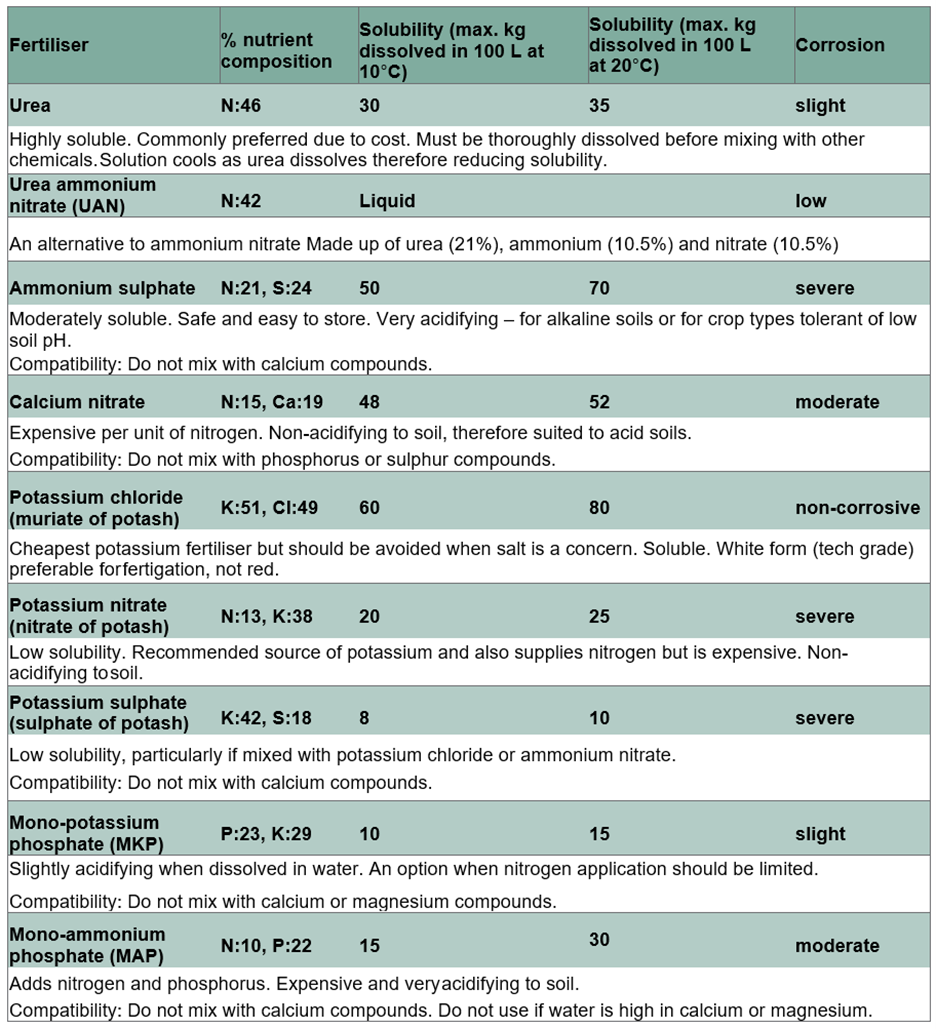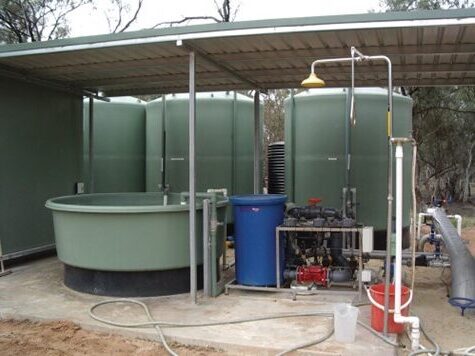Fertigation is the application of soluble fertilisers and micronutrients to crops through an irrigation system, and drip irrigation systems are highly suited to support this process, generally used to supply the crop’s nitrogen, phosphorus, potassium, calcium, and magnesium needs.
| Advantages | Disadvantages |
| – Less volatilisation as fertiliser is applied directly to the root zone increasing uptake efficiencies.
– Offer more control over shoot growth, yield, fruit quality and water use efficiency as fertiliser applications can be timed to crop requirements and physiological stages. – Leaching can be minimised by splitting applications overs several irrigations. – Reduced costs associated to manual application of fertilisers. – Reduces traffic over soil which decreases compaction rates and improves soil structure and health. – Allows accurate control of nutrient delivery. |
– Uniformity of chemical applications is directly dependent of irrigation system uniformity.
– Restricted to the use of soluble and liquid products. – Requires resistant fittings, regular flushing, and cleaning to avoid system corrosion. – Long-term use of ammonium-based nitrogenous fertilisers can cause soil acidity. The risk of soil acidification is much greater on acid soils than alkaline (It is important to know the soil pH when choosing a fertiliser). – Increased risk of system blockages if incompatible fertiliser is used. |
Quick tips:
- Nutrient concentrations are normally expressed as parts per million (ppm) in the irrigation water. In standard metric units, 1 ppm is equivalent to the following:
- 1 microgram (μg) of nutrient per g of product (solid) or per mL of product (liquid)
- 1 milligram (mg) of nutrient per litre (L)
- 1 gram (g) of the actual nutrient per 1,000 litres (1 cubic metre or 1 m3) of water
- 1 kg per megalitre (ML).
- Fertiliser injection timing should be long enough to ensure that equal amounts of fertiliser reach all trees in the area being irrigated.
- Most fertilisers are corrosive to metal. It is important to select components that are resistant to corrosion.
How to apply?
Calculations must be made back from kg/ha to estimate how much soluble fertiliser can supply for a given area. These calculations must consider the solubility of the fertiliser in the solution (see Table 1), the tank’s size, and the length of the injection period. Solubility is essential to consider when fertilising, as all fertilisers have different solubility levels, and temperature influences solubility. The composition and solubilities of some popular fertilisers are listed in Table 1 below.
Total urea supply = Concentration of N (100÷%) × amount nitrogen to apply (kg/ha) × area being fertigated (ha)
Volume of water needed = Total urea supply (kg) ÷ Solubility of urea in water at T ℃ (kg/L)

Table 1. Characteristics of various commercial fertilisers – nitrogen (N), phosphorus (P), potassium (K), Sulphur (S), calcium (Ca), chloride (Cl).
Injection timing
If fertiliser is injected during a typical irrigation to meet the crop’s water requirements, the general view is that the fertiliser should be injected as late as possible in the irrigation event, but still leaving enough time to flush the system clean following the injection.
Injecting late in the irrigation event leaves the fertiliser in the upper part of the root zone so that future irrigations will not push unused fertiliser past the root zone, leaving it available to the plant for longer.
Excessive irrigation should not be applied after fertigation. Many irrigators prefer to apply around 75% of their regular irrigation following fertigation to ensure minimal nutrient loss. Fertigation and leaching irrigations should be separate events, applied at different stages.
Quick tips:
- Some soluble fertilisers may not be suitable with others due to the formation of precipitants—separate injection of phosphorus/sulphur fertilisers from calcium fertilisers to avoid issues.
- Rinse equipment and irrigation system between injections. Many irrigators with intensive fertigation use separate injection tanks.
- For product compatibility, perform a simple jar test. Mix irrigation water with fertilisers (at the correct injection ratio, e.g., 1:5). Shake the mixture well to check for dissolution. If the solution is not mixing, avoid injection. Cloudiness, sedimentation, or coagulation after 24 hours indicates an unsuitable fertigation mix.
Safety precautions
Be aware and take note of any health and safety risks when designing/choosing your system. A design that does not take in consideration the physical health and practicality of the work for your employees and yourself may affect your safety.
- Chemical users should use protective equipment and be aware of community concerns about how chemicals might affect human health and environment.
- Always consult the manufacturer’s guidelines for transport, handling, storage, and use of chemicals – also discuss with sales representatives training available or any doubts you may have.
- Maintain your chemicals safety data sheet up to date, emergency services phones and safety procedures ready in case of emergency.
- Familiarise yourself and your family/workers with emergency procedures and treatment.
- Store your chemicals in cool areas, separate acids from oxidizing agents and ensure all products are labeled and secure.
To dive deeper into Fertigation tips visit Agriculture Victoria or Ask an expert.
https://agriculture.vic.gov.au/farm-management/water/irrigation/drip-irrigation/fertigation
This publication is provided solely for information purposes and no representation or warranty is made as to its quality, accuracy, completeness, suitability, or fitness for any particular purpose. You should make your own enquiries as to its appropriateness and suitability for your particular circumstances. The State of Victoria as represented by its Department Energy, Environment and Climate Change accepts no duty of care and disclaims all liability in relation to use of this publication.

